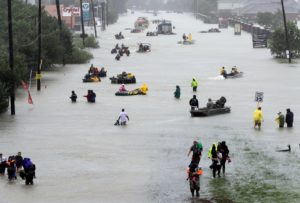
30 Aug A Perfect Storm
While the tragedy in Texas is the opposite of what we call perfection, it does meet the criteria of a perfect storm: when a number of things occur independently to heighten the potential of disaster.
When an area populated by millions floods to the extent that is still taking place even as I write, the disaster has multiple levels. Not only are roads and houses flooded with tens of thousands people displaced, but sanitation issues, fire ants, resulting mold, food shortages, and more, all come to play even in ways that have not yet played themselves out.
How will insurance companies cover the cost of destroyed cars or houses of so many at once? How will people deal with their losses, when claims take months or years? How will businesses get back to normal and people start earning a paycheck again?
Even hospitals are flooded, as well as schools, grocery stores, and all the things we take for granted that hold our local societies together.

Rescue boats fill a flooded street at flood victims are evacuated as floodwaters from Tropical Storm Harvey rise Monday, Aug. 28, 2017, in Houston. (AP Photo/David J. Phillip)
This storm may be unprecedented in scale and severity, but unless we deal with the climate crisis, storms like this will become the norm. Clearly, we are not equipped to deal with it in large metropolitan areas – there is not even person power, money, or infrastructure to handle it all. Some say it may take not days or weeks, but months or years, to get back to normal.
We can’t afford this level of tragedy and suffering. We can’t afford storms that could be this bad or even worse to happen more frequently.
We must put climate issues front and center in all our agendas.
It’s not just that the temperature is going to get hotter. I recently read Lawrence Wollersheim’s book Climageddon, which ties together the many tipping points that will lead to a global warming crisis if we don’t mobilize everything toward its mitigation right now. As the ice melts, shrinking the white reflective surface that sends heat back out, temperatures will increase. As the tundra melts, it will release methane, a powerful greenhouse gas. As wind blows, the soil dries out and fires increase. As trees burn, there are less plants to fix carbon. As the ice melts, microbes we haven’t seen in thousands of years are released into the water supply. As carbon continues to acidify the ocean, plankton are dying, which supply 50% of the world’s oxygen.
Let’s not allow the suffering in Houston to be wasted in the kind of ignorance that allows further tragedies of this sort to occur.
See Al Gore’s new movie, An inconvenient Sequel. Read Lawrence Wollersheim’s book, Climageddon. Sign on the petitions that allows cities and states to stay in the Paris Climate agreement. Switch to hybrid or electric cars, solar on your house, or a less meat based diet, and anything else you can do to help keep the climate stable.
Next time it could be your neighborhood.
Anodea Judith
08.28.17


No Comments